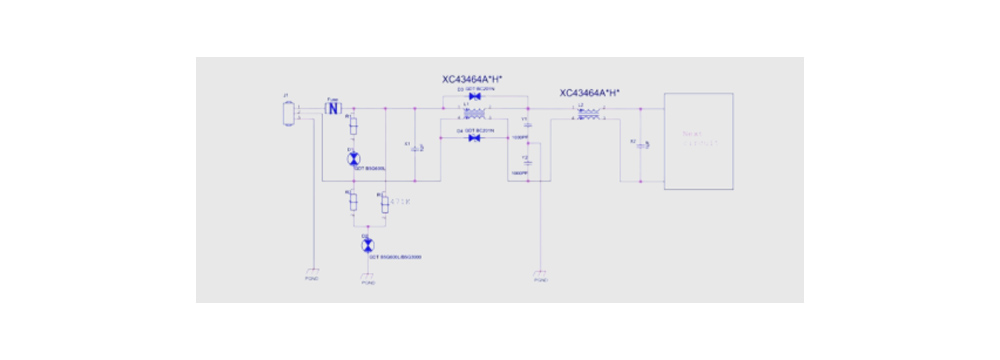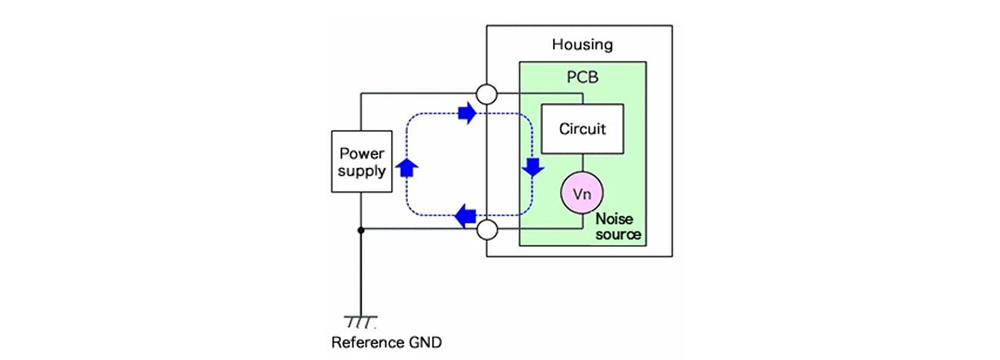In today's era where electronic devices are everywhere, the importance of electromagnetic compatibility (EMC) has become increasingly prominent. Whether it is the mobile phones and computers we use daily or the large-scale equipment in industrial production, good EMC performance is indispensable. It is not only related to the stable operation of the equipment itself, but also affects the normal operation of other surrounding equipment. Today, let us go deep into the world of EMC and fully understand the relevant knowledge, especially the generation and response strategies of switching power supply noise.
To understand EMC, we must first understand that it contains two key aspects: electromagnetic interference (EMI) and electromagnetic susceptibility (EMS). EMI refers to the radiation of electromagnetic waves from the equipment to the outside world during operation, thereby interfering with the normal operation of other equipment; while EMS reflects the resistance of the equipment to external electromagnetic interference. The two are interrelated and jointly determine the compatibility of the equipment in a complex electromagnetic environment. Just like a harmonious community, each "resident" (equipment) must not only not disturb others (low EMI), but also have the "steadiness" (high EMS) to be unaffected by external interference.
The spectrum plays an important role in EMC. The change of frequency will affect the spectrum amplitude. When the frequency increases, the spectrum amplitude shows an overall upward trend. At the same time, the delay of the signal rising or falling will also change the attenuation characteristics of the spectrum, reducing the frequency entering the -40dB/dec attenuation, and the amplitude will decay accordingly. In addition, although the change of duty cycle will cause even harmonics, it has little effect on the spectrum peak, but it will cause the fundamental spectrum to attenuate. These characteristics are like passwords, hiding the changing laws of electromagnetic signals. Only by mastering them can we better understand and deal with electromagnetic compatibility issues.
Conducted noise in electromagnetic interference can be further divided into differential mode (normal mode) noise and common mode noise. Differential mode noise and common mode noise have different generation mechanisms and different effects on equipment. Conducted noise and radiated noise are the main types of EMI, among which radiated noise is greatly affected by factors such as the cable loop area of differential mode noise and the line length of common mode noise. It is worth noting that under the same conditions, the radiation intensity caused by common mode noise is much greater than that of differential mode noise. In addition, crosstalk will occur when parallel wiring is used. It is mainly caused by capacitive (electrostatic) coupling caused by stray (parasitic) capacitance and inductive (electromagnetic) coupling caused by mutual inductance, just like the driving of vehicles on two adjacent roads will affect each other.
As a common component in electronic equipment, switching power supply will generate unique switching noise when working. When the switch is in action, the rapidly changing current will generate high-frequency ringing in the loop due to parasitic components, which is the source of switching noise. Although we can reduce some noise by optimizing PCB board wiring and other methods, the residual noise may still be transmitted to the input power supply in the form of common-mode noise, thereby affecting the performance of the entire device. Therefore, it is urgent to find effective noise reduction measures.
1. Switching power supply noise
Definition:
Noise is a general term for all signals other than the target signal. In electronic circuits, all signals other than the target signal, regardless of whether it affects the circuit, can be called noise.
Cause:
Switching power supply noise mainly comes from the switching operation of switching elements and high-frequency oscillating current. These noise signals are propagated through electromagnetic waves in the power supply line and may interfere with nearby sensitive circuits.
Noise is generated by two reasons, one is generated by the switching power supply itself, and the other is the interference of external electromagnetic fields (EMI), which can enter the switching power supply through radiation or enter the switching power supply through the power line. The noise generated by the switching power supply itself is a high-frequency pulse train caused by the sharp pulses generated at the moment of switch on and off, also known as switching noise.
Impact:
Noise may have an adverse effect on the circuit, causing the audio device to emit AC sound or cause the circuit to malfunction.
When a noise voltage is large enough to interfere with the circuit, the noise voltage is called interference voltage.

2. EMC (Electromagnetic Compatibility)
Definition:
EMC is electromagnetic compatibility, which is the abbreviation of Electromagnetic Compatibility in English. Electromagnetic compatibility (EMC) means that when the equipment is working, it can not only operate stably in a normal working environment, but also avoid interference with other electronic equipment, and can withstand external electromagnetic interference without affecting its normal function.
Contents:
EMI (Electromagnetic Interference): that is, when the equipment or system is in a certain environment and operates normally, it should not generate electromagnetic energy exceeding the requirements of the corresponding standards.
EMS (electromagnetic sensitivity): that is, when a device or system is in a certain environment and is operating normally, the device or system can withstand electromagnetic energy interference within the range specified by the corresponding standard, or the device or system is insensitive to electromagnetic energy within a certain range and can maintain normal operation according to the designed performance.
Electromagnetic environment: that is, the working environment of the system or equipment.
The root cause of EMC problems:
The propagation of electromagnetic waves and the mutual influence between devices. In power supply design, especially switching power supplies, due to their high-frequency switching characteristics, a large amount of electromagnetic noise is often generated during the switching process. These noises affect the surrounding circuits or equipment through radiation or conduction, which leads to system instability or abnormal operation.
In solving EMC problems, especially switching power supply noise, it is crucial to take scientific and reasonable noise reduction measures. Noise reduction must follow certain steps, and the difficulty and cost of noise reduction are different at different stages of product development. As the development process progresses, the noise reduction methods that can be used will gradually be limited, and the cost will continue to increase. Therefore, it is key to fully explore and evaluate in the early stages of product development. First, we need to accurately grasp the frequency component of the noise, identify its source and conduction path, then strengthen the grounding measures, and finally reasonably increase the noise reduction components.
In terms of the specific method of reducing the noise of the switching power supply, for differential mode noise, it can be achieved by reducing the loop area of the large current path on the circuit board and adding appropriate decoupling and input filters. Suppressing the source of differential mode noise can not only reduce the differential mode noise itself, but also has a positive effect on reducing common mode noise. For common mode noise, it is necessary to shorten the wiring, suppress crosstalk, and cut off the common mode path.
Capacitors and inductors are powerful assistants in the noise reduction process. When selecting a capacitor for noise reduction, you cannot only look at the capacitance, but also the frequency characteristics of its impedance. The smaller the capacitance and equivalent series inductance (ESL), the higher the resonant frequency and the lower the impedance in the high frequency region; the larger the capacitance, the lower the impedance in the capacitive region; the smaller the equivalent series resistance (ESR), the lower the impedance at the resonant frequency; the smaller the ESL, the lower the impedance in the inductive region. By reducing the impedance of the target noise frequency, the noise amplitude can be effectively reduced. When using decoupling capacitors, pay attention to using multiple capacitors and reducing the ESL of the capacitors, which can improve high-frequency characteristics and more effectively reduce high-frequency noise. At the same time, it is also necessary to pay attention to the relationship between the Q value and the frequency-impedance characteristics, as well as the impact of factors such as PCB graphics and capacitor temperature characteristics on the noise reduction effect.
Inductors also play an important role in noise reduction. Before the resonant frequency, the inductor exhibits inductive characteristics, and the impedance increases with the increase of frequency; after the resonant frequency, it exhibits capacitive characteristics, and the impedance decreases with the increase of frequency. In the frequency band above the resonant frequency, the inductor cannot play the role of an inductor. When the inductance value L becomes smaller, the resonant frequency will increase, and the impedance at the resonant point is limited by the parasitic resistance component. The inductors used for noise reduction are mainly two types: filters composed of winding inductors and heat conversion using ferrite beads. Ferrite beads have a larger resistance component R and a lower Q value, and have different characteristics and applicable scenarios compared with ordinary inductors.
In addition, there are some other noise reduction countermeasures. For example, the RC snubber circuit can convert the spike voltage generated by parasitic capacitance, parasitic inductance, etc. into heat through resistance, thereby reducing the spike voltage. However, adding a snubber circuit may lead to reduced efficiency, so it is necessary to find a balance between noise level and efficiency, and pay attention to the allowable loss of the resistor.

3. The relationship between switching power supply noise and EMC
The impact of switching power supply noise on EMC:
The noise generated by the switching power supply, especially the high-frequency noise, will interfere with the surrounding electronic equipment through radiation or conduction, thereby affecting the electromagnetic compatibility of the entire system.
Application of EMC countermeasures in switching power supplies:
Filtering technology: Using a suitable filter to suppress high-frequency noise is an effective means to reduce EMC interference. The filter isolates the high-frequency noise signal from the main circuit by adding an inductor, capacitor or LC filter to the input or output of the power supply, reducing the propagation of noise.
Shielding technology: Design a suitable shielding structure and shielding material to reduce electromagnetic radiation. For example, use a metal shielding cover to cover the key components of the switching power supply, or use a shielding layer in the PCB layout to isolate sensitive circuits and interference sources.
Grounding technology: Control the grounding of the equipment to ensure a good grounding connection. Reasonable grounding design can reduce the impedance of the ground loop, reduce common-mode interference, and improve the electromagnetic compatibility of the system.
Wiring optimization: Optimize the wiring of power and signal lines to reduce crossover and coupling. Avoid long and thin wires to reduce electromagnetic radiation and interference from sensitive equipment. At the same time, control the wiring paths of signal lines and power lines to reduce interference crossover and coupling.
Use low-noise components: Select low-noise switching components, filters, and rectifier diodes, etc., to reduce the generation of electromagnetic interference from the source.
Electromagnetic compatibility simulation and testing: Perform electromagnetic compatibility simulation and testing in the design stage to discover and solve problems in a timely manner. Evaluate the EMC performance of the switching power supply by simulating the real electromagnetic environment, and optimize the design based on the test results.
Comply with relevant standards and specifications: Comply with relevant electromagnetic compatibility standards and specifications to ensure that the product meets the requirements. This can not only improve the market competitiveness of the product, but also avoid legal disputes and economic losses caused by electromagnetic interference problems.
In order to suppress the noise of the switching power supply and improve electromagnetic compatibility, a variety of EMC countermeasures can be taken, such as filtering technology, shielding technology, grounding technology, wiring optimization, etc.
In summary, switching power supply noise and EMC are issues that need to be focused on in the design and application of electronic equipment. By deeply understanding the working principle of the switching power supply and the generation mechanism of EMC interference, and taking effective suppression measures, the electromagnetic interference effect of the switching power supply on the environment and other electronic equipment can be significantly reduced, and the stability and reliability of the entire system can be improved.
EMC knowledge is essential for the development of electronic technology. By mastering the basics of EMC and understanding the generation mechanism and noise reduction methods of switching power supply noise, we can better deal with various electromagnetic compatibility issues in the design, manufacture and maintenance of electronic equipment. With the continuous advancement of electronic technology, the requirements for EMC performance will become higher and higher. I hope everyone can attach importance to the knowledge in this field and contribute to the development of electronic technology.
Share our interesting knowledge and stories on social media













